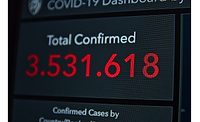Improving Safety and Security through Digital Signage

In 1964, communication theorist Marshall McLuhan famously said, “The medium is the message.” A half-century later, this idea rings truer than ever. As people grow more and more accustomed to receiving and exchanging information through digital devices, other forms of communication are entirely overlooked. A public service announcement displayed on a poster or an ad featured in a print publication may go unnoticed, no matter what the content.
Security executives should take notice of the dramatic shift to digital communication. For safety and security-related communication in a business environment, messages must not merely be sent, they must also be received, sometimes with time being of the essence. In industrial sectors – such as utilities, oil and gas, chemical and manufacturing – the risks of faulty safety and security communication are high. Beyond industrial companies, any business has exposure to theft and other crime along with weather-related risk. In each setting, the need for timely safety and security communication is critical.
By conveying information quickly and potentially in real time through high-impact digital signage, chief security officers put the odds in their favor of distributing safety and security messages thoroughly, and in a way that registers with recipients. Consider some examples:
- Safety messages, including reminders and performance metrics (e.g., number of accident-free days) may go unnoticed when posted on static wall signs in facilities. However, when information is conveyed in real time and via digital technology, employees are more likely to notice. Flashing scoreboards, frequently changing content and other visual techniques can be used to ensure that messages are seen and noticed by all employees no matter where they are.
- For emergency notifications such as tornado warnings or chemical spills, real-time digital messaging becomes even more important to helping a company reduce injuries and damages. Critical messaging about an event or response to an event can be conveyed and consumed immediately using digital tools across desktop, signage and mobile platforms.
- Digital signage can be integrated with other security systems by using video feeds from cameras in combination with TV screen displays of surveillance footage to safety personnel. Real-time transmission of information allows companies to react quickly, preventing a bad situation from becoming worse.
- Digital communication attracts attention in part because of motion: A scrolling ticker on public digital screens with up-to-the-minute information on a developing weather event or live updates on an in-plant accident can instantaneously draw attention to key matters.
- In the same way, digital reminders about important safety practices, such as wearing safety goggles or staying hydrated carry far more persuasive power when communicated visually (e.g., video clips, graphics, etc.) on digital displays, desktop monitors, and smartphones. A verbal or textual reminder to drink water is not nearly as powerful as watching a video of what could happen if a worker becomes dehydrated (make mistakes, etc.).
Digital communication – especially when it’s real time and visual – promotes safety and security widely and deeply within an organization, improves response time and prevents accidents, injuries and related costs.
Alcoa has demonstrated the business value of making safety a priority: During a 13-year period of emphasizing safety, lost workdays due to injury plunged 89 percent, accompanied by a five-fold increase in annual net income. Many analysts credit this safety initiative for saving the entire company.
Despite such convincing data, OSHA safety citations continue to be issued for a wide range of issues, such as respiratory protection, lockout/tagout procedures, electrical wiring methods, and forklifts. For many of the problems, a lack of proper signage is a contributing factor. The good news is: signage is a relatively easy problem to fix.
A digital signage communication plan for safety and security works best when it delivers contextual, visual information based on live events and current information. Smarter data – such as live feeds from surveillance monitors – give an interactive dimension to communication that helps employees understand not only what is happening now, but also how to respond based on that knowledge.
Implementing a digital communication network that taps into timely information sources and reaches employees wherever they are can have a profound impact on safety and security results. At a minimum, the network will improve a company’s ability to distribute safety and security information more efficiently. At maximum, it will change individual behavior and corporate culture – for the better.
Looking for a reprint of this article?
From high-res PDFs to custom plaques, order your copy today!








